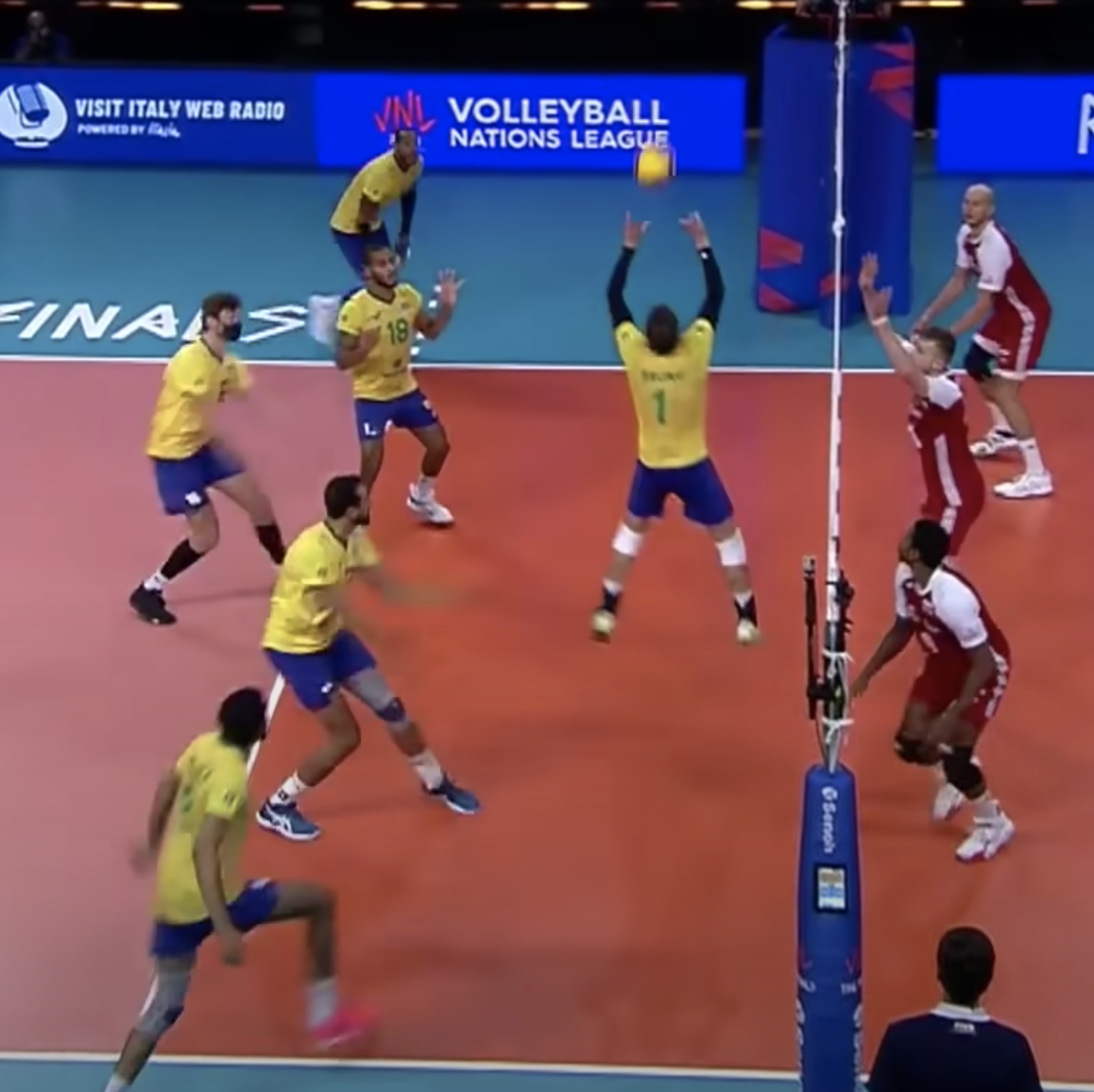Play Volleyball Better
Indoor volleyball is a simple game made overly complicated by those who coach and play it. Either you’re trying to put the ball on your opponent’s floor, or keep them from putting it on yours. Sure, there’s some rules tossed in there about how you flick or fondle the ball, but it’s still a simple game. But simple shouldn’t mean boring and predictable. You could set a watch to some offenses. When you play creatively, unpredictably, you win.
Oooh, the outside hitter attacked an inside set? How spicy. They’ll never see that coming.
Middle ran a slide? Revelatory.
The opposite approached at a faster tempo? Never seen that before.
A free-ball is immediately set and then attacked by an outside hitter? Wait, what?
Yeah, that’s an option for Brazil’s men’s national team. And it works—because it is more unpredictable than the prototypical three-touch offense. It should be something you and your team are capable of too. It’s not that hard. Attacking on the second touch is one of the biggest opportunities I see for teams. I’m going to tell you more about this winning strategy and a few others ripe for the taking. But first, we need to talk about predictions.
Unpredictable = W. Predictable = L
Most of the time, you’ll see an offense spread across the net—attackers jet down the sidelines and someone poses a threat out of the middle. Splitting the offense over the greatest distance creates the highest likelihood of hitters getting one-on-one scenarios against blockers. Got it, that’s a favorable offense (and makes middle the hardest position). But why do so many teams play this way 100 percent of the time?
Because it’s the way it’s always been done. Because normalcy has lulled us into law-abiding complacency. (Except there are no laws that demand these strategies, just the yoke of tradition.) Because it’s perceived as fun-da-men-tal. But playing one way is predictable and predictable teams get beaten. Such monotony and utterly prude playing styles creates less skillful players and beatable teams.
Instead of playing the traditional way, you should have multiple strategies up your sleeve. The more options you have to score, the harder you are to predict. If you’re hard to predict, defenses will struggle. If you’re easy to predict, because you run the same offense over and over, you will get blocked and dug until you lose.
That jelly-filled noggin of yours is a prediction making organ. In volleyball, brains try to predict where the ball will go. They predict the attack, the serve, the block, the dig, or the set, so they can either put the ball on the ground or keep it off the ground. When teams and players play creatively, unpredictably, their opponents have a hard time knowing what’s coming. So, playing with the same repeatable offense spread across the net for every point of the match is not a good idea. It still results in two, sometimes three blockers. (The matchups between attackers and blockers is an important point I will stress throughout this post.) The following may seem like an obvious statement, but it gets missed all the time: If you create offenses that result in one-on-one scenarios at the net, you’re likely to win more points. If you can face zero blockers, even better. So create those opportunities.
There are three opportunities I see readily available to varsity high school, collegiate, and professional teams alike: attacking on the second touch, more players running quick(ish) attacks at the same time, and something completely new with serving. The first two opportunities could be easily used in freeball scenarios.
Opportunity #1: Attack On The Second Touch
Watch this gorgeous bit of keep-the-ball-off-the-ground by South American volleyball powerhouse, Brazil.
The freebie came over and both the outside and opposite hitters were ready to attack. It’s obvious they have practiced this—a lot. When the set is made, there’s only two blockers at the net! Poland played some amazing defense but Brazil clearly dominated every attack of the rally with extremely favorable matchups between attackers and blockers because they played unpredictably.
And again. (Note the one-on-one, highly favorable matchup.)
Japan attacked on second touch. It ain't as pretty but it worked.
Opportunity #2: More Quick Attacks
Speed is always harder to predict. Setting faster or just hitting harder can be an effective strategy for any team. Watch that first Brazil clip again, and you’ll see our next opportunity: more attackers on quick tempos. Four attackers approach at nearly the same time against three blockers? Four against three. Yeah, that’s a favorable matchup.
This play isn’t that difficult. Any team can run it. It just takes a decent pass, clear communication, and a lot of practice.
(And here we see Nebraska running the same offense that’s run across the country. Three instead of four attackers, at normal tempos. The blockers can easily triage who is the biggest threat. They predicted where the set went and two jumped against the middle.)
Brazil has been coached to creatively capitalize on freeballs. They got two in the same play and ran two separately unpredictable offenses. These creative replies are such obvious opportunities I’m dumbfounded that more teams don’t take advantage of them. If someone gives you a free-ball, you ought to capitalize.
In the women’s 2021 NCAA championship, countless freeballs were sent over the net. Most of them were received and wasted with traditional, aka predictable plays. Like this one. And this one. And this one. And this last one where Nebraska won the point but against two blockers, a statistically unfavorable scenario.
In the men’s 2021 NCAA championship, I saw the same story. Sigh. Hawaii dominated this match and BYU handed them a lot of freeballs, but they missed plenty of opportunities.
Hawaii won the point but what else could they have done with that free-ball-gem served up on a silver platter?
Hawaii got another freeball. They faced three blockers but still won the point. I see a highly predictable offense and an unfavorable amount of blockers. I would have set the opposite hitter immediately—the respective blocker was still ten feet away from the net! A much higher percentage attack option was available and wasted.
Finally, a glimpse of creative play by Hawaii: The right side attacked on the second touch against zero blockers. BYU didn’t predict it. That’s a high percentage play I want to see more and more.
Varsity high school teams could run these plays. These top tier collegiate teams are perfectly capable of attacking on the second touch and running different routes and tempos, especially on freeballs, but the majority still play the game how it’s always been played. That leads to more predictable offenses, more blockers against attackers, and lower chances of points scored per attack. So, why hold onto tradition?
Opportunity #3: More Varied Serving
In our sport, servers are as machine-like as possible from behind the endline. Everyone has their special way of getting the ball over the net, a snowflake generation indeed. I understand the reasons: Serving is hard. Reduce variables by creating a predictable serving routine. And if you look the same every time you serve, it can be hard to predict where the ball will go. But here’s my issue, why just one routine? Why not have an armory of options?
If you’re getting lit up by passers with every attempt, why keep trying the same thing? Why not start somewhere else? Why not add a diagonal to your approach? Why not change the tempo?
When you’re losing, opponents are predicting you. The last thing you should do is more of the same! What you’re supposed to do is change, adapt. That’s competing—and why you need a menu of serves and offensive strategies. Be unpredictable.
For elite teams, I see varied serves as an opportunity. For high schoolers and youth, I see it as a responsibility. If they are handcuffed to their routine, they’re not very skillful. They’re machines programmed for one way of doing things. If one player accidentally changed the slightest thing in her toss, or something in her environment changed, and she can’t adapt to it, that’s a poor set of skills. When coaches invite more variability into practice, they create more adaptable players. The more ways a player can play volleyball, the more skillful she is, the more adaptable she is. The more ways offenses can score points, the more skillful they are. The only obstacles you’ll face are all the necessary mistakes that come on the path of mastery.
Doing things the way they’ve always been done is predictable. It’s also boring as hell. At the elite level, I see less traditional volleyball. It’s actually fun (for me) to watch. Some of those innovations are attainable. It just takes willing, curious, and patient coaches.



